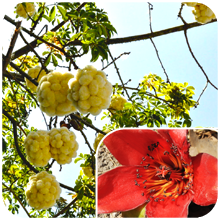
Salmalia malabarica grows to an average height of 20 meters (old trees up to 60 meters), in tropical humid conditins. Trunk and limb bear numerous conical spines especially when young, but get eroded with age. The leaves are palmate with about 6 leaflets radiating from a central point, an average of 7- 10 cm wide, 13- 15 cm in length. Petiole of leaves is long flexible up to 20 cm long. Flowers are cup-shaped, solitary or in groups, axillary or terminal sub-bundles or near the ends of the branches of the tree where the leaf has an average of 7 to 11 cm breadth, 14 cm in width, petals are up to 12 cm in length, the calyx is usually tri-lobed, an average of 3 to 5 centimeters in diameter in the form of a cup. Staminal tube is short, more than 60 in five bundles. Stigma is light red, 9 cm long, the ovary is pink, 1.5- 2 cm long, covered with white silky hair to 1 mm length. Seeds are numerous, long, ovoid, black or gray in color and covered with white cotton. The fruit, which reaches an average of 13 cm to the length, is light-green in color when immature but at maturity, fruits get brownish color.
Chemical composition – Gum from the bark contains katechuic acid, sugar, “semulrot” ash with CaCO3, MgCO3, tannic and gallic acids. Seed oil contains fatty acid mixture containing oleic acid as the major constituent together with myristic acid, palmitic acid, arachidic and linoleic acid. Flowers contain seven flavones: vicenine, linarine, saponarine, cosmetine, isovitexine, xanthomicrol and apigenine. Seeds contain n-hexacosanol, palmitic acid, octadecyl palmitate, gallic acid, tannic acid, 1-Gallyl-B-glucose ethyl gallate and a mixture of a, b and y-tocopherol. Flowers contains 10 flavonoids, quercetine, quercetine-3-O-beta-D-glucopyranoside, quercetine-3-O-beta-D-glucuronopyranoside, rutine, sexangularetin-3-O-soforoside, vitexine, isovitexine, vicenine 2, kaempferol- 3-O-rutinoside and kaempferol-3-O-beta-D-glucuronopyranoside, three xanthones, isomangiferin, mangiferin, and 7-O-methyl mangiferin; four coumarins, esculetine, scopoletine, fraxetine and scopoline; and seven compounds blumenol C glucopyranoside, benzyl-ß-D-glucopyranoside, phenylethyl rutinoside, protocatechulic acid, chlorogenic acid, methyl chlorogenate vanillic acid.
Properties – Stimulent, restorative, astringent, aphrodisiac, demulcent, emetic, tonic and diuretic.
Recommendation – Diarrhoea, dysentery, diabetes, leucorrhoea, phthysis, inflammation and rheumatic pains, gonorrhea, headaches, asthma, tooth decay, menorrhagia, conjunctivitis, chronic inflammation of the kidneys and bladder, genital weakness, dysuria, splenomegaly, seminal debility.
This plant is incorporated in natural remedy SHECURE Syrup.




